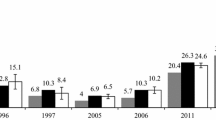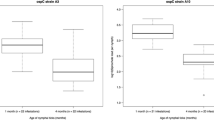Abstract
Ixodes ricinus is an important vector ofBorrelia burgdorferi in Europe, and small rodents (Apodemus flavicollis, A. sylvaticus andClethrionomys glareolus) are important sources for infecting ticks. In this study, we examined their reservoir role by studying the duration of their infectivity for ticks.A. flavicollis andA. sylvaticus mice captured in nature were exposed to uninfectedI. ricinus larvae at different times after their capture: 10 days, and 2, 7, 11, 14 and 40 months. Ticks were examined for spirochaetes after moulting using direct immunofluorescence. All animals remained infective for ticks their life long but the efficiency of transmission from hosts to ticks varied from one individual to the other, presenting a three-fold variation (26.5% to 81.4%). Rodents continously exposed to successive infestations by larvalI. ricinus ticks over a period of one month showed an enhancement of infectivity for larval ticks during this period.
Similar content being viewed by others
References
Aeschlimann A, Chamot E, Gigon F, Jeanneret JP, Kesseler D Walther C.Borrelia burgdorferi in Switzerland. Zentbl Bakt Hyg 1986; 263: 450–458.
Hovmark A, Jeanson TGT, Asbrink E, Forsman A, Jansson E. First isolation ofBorrelia burgdorferi from rodents collected in Northern Europe. Acta Path Microbiol Scand 1988; 96: 917–920.
Humair PF, Turrian N, Aeschlimann A, Gern L.Borrelia burgdorferi in a focus of Lyme borreliosis: The epizootiologic contribution of small mammals. Folia Parasitol 1993; 40: 65–70
Kurtenbach K, Dizij A, Kampen H, Moter S, Wallich R, Schaible UE, Simon MM. European wild rodents as reservoir hosts ofBorrelia burgdorferi: Ecological and immunological aspects. 5th International Conference Lyme Borreliosis, Arlington, USA, 1992; abstract 293.
Vittoz N, Humair PF, Siegenthaler M, Aeschlimann A, Gern L. Mammalian and avian reservoirs forBorrelia burgdorferi in a Lyme borreliosis focus in Switzerland. Rev suisse Zool 1990; 97: 783.
Oliver JH, Owsley MR, Hutcheson HJ, James AM, Chen C, Irby WS, Dotson EM, Mclain DK. Conspecificity of the ticksIxodes scapularis andI. dammini (Acari: Ixodidae). J Med Entoml 1993; 30: 54–63.
Burgdorfer W, Schwan T. Lyme borreliosis: A relapsing fever-like disease? Scand J Inf Dis Suppl 1991; 77: 17–22.
Donahue JG, Piesman J, Spielman A. Reservoir competence of white-footed mice for Lyme disease spirochetes. Am J Trop Med Hyg 1987; 36: 92–96.
Schwan T, Karstens RH, Schrumpf ME, Simpson W. Changes in antigenic reactivity ofBorrelia burgdorferi, the Lyme disease spirochete, during persistent infection in mice. Can J Microb 1991; 37: 450–454.
Brumpt E. Le xénodiagnostic: application au diagnostic de quelques infections parasitaires et en particulier à la Trypanosomiase de Chagas. Bull Soc Path Exot 1914; 7: 706–710.
Gern L, Toutoungi LN, Hu CM, Aeschlimann A.Ixodes (Pholeoixodes) hexagonus, an efficient vector of Borrelia burgdorferi in the laboratory. Med Vet Ent 1991; 5: 431–435.
Barbour AG, Tessier SL, Todd WJ. Lyme disease spirochetes and ixodes tick spirochetes share a common surface antigenic determinant defined by a monoclonal antibody. Inf Immun 1983; 41: 795–804.
Barbour AG. Isolation and cultivation of Lyme disease spirochetes. Yale J Biol Med 1984; 57: 521–525.
Hu CM, Gern L, Aeschlimann A. Changes in the protein profile and antigenicity ofBorrelia burgdorferi strains after reintroduction to Ixodes ricinus. Paras Immun 1992; 14: 415–427.
Fienberg S. Linear logistic response models. In: The analysis of cross classified categorical data, 2nd ed. MIT Press, 1991: 102–105.
Draper NR, Smith H. The examination of residuals. In: Applied regression analysis. Wiley and Sons, 1966: 86–103.
Hu CM, Leuba-Garcia S, Gern L. Distribution of phenotypes ofBorrelia burgdorferi isolated fromIxodes ricinus in two endemic areas in Switzerland. First Int Conf Tick-Borne Path Host-Vector Interface: An Agenda for Research, St Paul, USA, 1992.
Wilske B, Preac-Mursic V, Schierz G, Kühbeck R, Barbour AG, Kramer MD. Antigenic variability ofBorrelia burgdorferi. Ann NY Acad Sci 1988; 593: 126–143.
Ribeiro JMC, Makoul GT, Levine J, Robinson DR, Spielman A. Antihemostatic, antiinflammatory and immunosuppressive properties of the saliva of a tick,Ixodes dammini. J Exp Med 1985; 161: 332–344.
Randolph SE. Population regulation in ticks: The role of acquired resistance in natural and unnatural hosts. Parasitology 1979; 79: 141–156.
Author information
Authors and Affiliations
Rights and permissions
About this article
Cite this article
Gern, L., Siegenthaler, M., Hu, C.M. et al. Borrelia burgdorferi in rodents (Apodemus flavicollis andA. sylvaticus): Duration and enhancement of infectivity forIxodes ricinus ticks. Eur J Epidemiol 10, 75–80 (1994). https://doi.org/10.1007/BF01717456
Accepted:
Issue Date:
DOI: https://doi.org/10.1007/BF01717456




